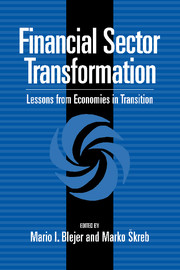Book contents
- Frontmatter
- Contents
- List of Contributors
- Introduction: Financial Reforms and Economic Transition: An Overview of the Major Issues
- PART I GENERAL STUDIES
- 1 Monetary Policy during Transition: An Overview
- 2 Toward Market-Oriented Banking in the Economies in Transition
- 3 The Trials and Tribulations of Banking in Transition Economies: A Political Economy Perspective
- 4 Financing Transition: Investing in Enterprises during Macroeconomic Transition
- PART II COUNTRY STUDIES
- PART III AFTERWORD
- Index
4 - Financing Transition: Investing in Enterprises during Macroeconomic Transition
Published online by Cambridge University Press: 05 November 2011
- Frontmatter
- Contents
- List of Contributors
- Introduction: Financial Reforms and Economic Transition: An Overview of the Major Issues
- PART I GENERAL STUDIES
- 1 Monetary Policy during Transition: An Overview
- 2 Toward Market-Oriented Banking in the Economies in Transition
- 3 The Trials and Tribulations of Banking in Transition Economies: A Political Economy Perspective
- 4 Financing Transition: Investing in Enterprises during Macroeconomic Transition
- PART II COUNTRY STUDIES
- PART III AFTERWORD
- Index
Summary
Macroeconomic stability can be viewed as a classic pure public (intermediate) good, both nonrival and nonexcludable Macro-economic stability boosts the quantity and quality of investment. In turn, productive investment is one of the key determinants of economic growth and rising living standards. The provision of macroeconomic stability is a natural responsibility of the government.
Macroeconomic instability often manifests itself through outright inflationary financing or else through a rising public debt- GDP ratio that is not matched by a rising capacity for generating future public (primary) budget surpluses necessary to repay that debt. There is a growing body of empirical evidence (and some recent theoretical research) on the existence of a close link between macroeconomic stability and economic growth (see, e.g., Fischer 1991, 1993; Barro 1995; Easterly 1996; and Bruno and Easterly 1996).
In the economies of Eastern Europe and the former Soviet Union (FSU), the swift and wide-ranging price liberalization measures with which transition was started and the initial monetary overhang inherited from the central-planning era caused an initial big spike in the rate of inflation. Some countries, like the former Czechoslovakia, Croatia, Hungary, Poland, Slovenia, and the Baltics were indeed able, through restrictive macroeconomic policies, to prevent what was fundamentally a one-off shock from turning into a process of high inflation. Others were less successful and perpetuated high inflation for several years. In the advanced countries, though, not everything was solved in one blow. Some of the countries successful in disinflation soon confronted unfolding disequilibria in the current account of the balance of payments that translated partly into buildup of private and/or public external debt.
- Type
- Chapter
- Information
- Financial Sector TransformationLessons from Economies in Transition, pp. 150 - 192Publisher: Cambridge University PressPrint publication year: 1999
- 2
- Cited by

